flat tire MITSUBISHI OUTLANDER 2020 Owner's Manual (in English)
[x] Cancel search | Manufacturer: MITSUBISHI, Model Year: 2020, Model line: OUTLANDER, Model: MITSUBISHI OUTLANDER 2020Pages: 443, PDF Size: 60.03 MB
Page 12 of 443
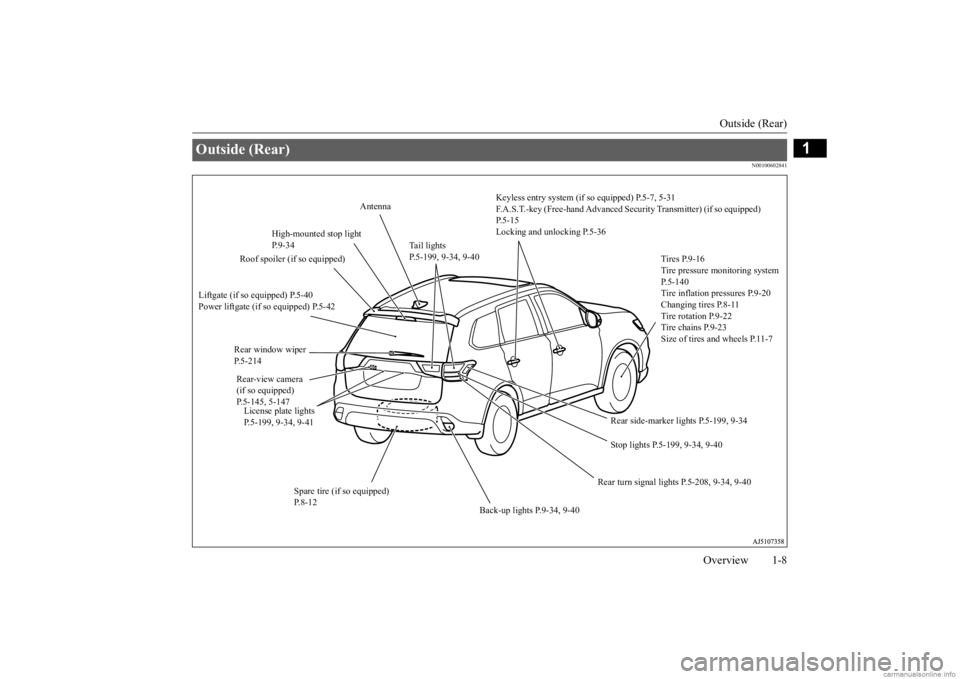
Outside (Rear)
Overview 1-8
1
N00100602841
Outside (Rear)
Keyless entry system (if so equipped) P.5-7, 5-31 F.A.S.T.-key (Free-hand Advanced Se
curity Transmitter) (if so equipped)
P.5-15 Locking and unlocking P.5-36
Tires P.9-16 Tire pressure monitoring system P.5-140Tire inflation pressures P.9-20Changing tires P.8-11 Tire rotation P.9-22 Tire chains P.9-23Size of tires and wheels P.11-7
Stop lights P.5-199, 9-34, 9-40
Rear turn signal lights P.5-208, 9-34, 9-40
Spare tire (if so equipped) P.8-12
Back-up lights P.9-34, 9-40
License plate lights P.5-199, 9-34, 9-41 Rear-view camera (if so equipped) P.5-145, 5-147 Rear window wiper P.5-214
High-mounted stop light P.9-34
Antenna
Liftgate (if so equipped) P.5-40 Power liftgate (if so equipped) P.5-42
Rear side-marker lights P.5-199, 9-34
Tail lights P.5-199, 9-34, 9-40
Roof spoiler (if so equipped)
BK0278200US.book 8 ページ 2019年4月10日 水曜日 午前10時59分
Page 16 of 443
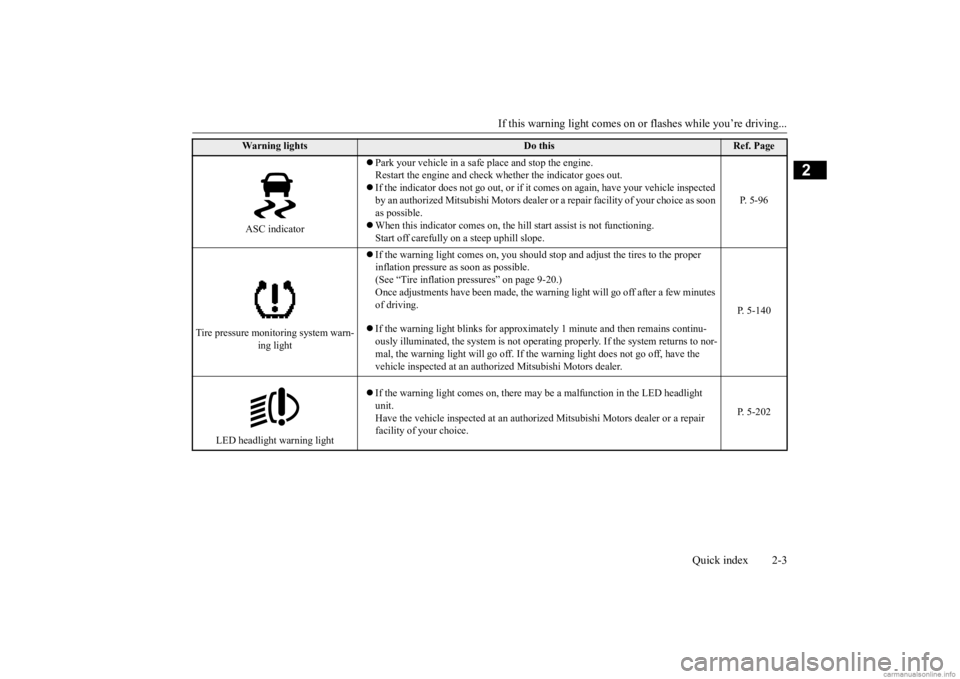
If this warning light comes on or
flashes while you’re driving...
Quick index 2-3
2
ASC indicator
Park your vehicle in a safe
place and stop the engine.
Restart the engine and check
whether the indicator goes out.
If the indicator does not go out, or if it co
mes on again, have your vehicle inspected
by an authorized Mitsubishi Motors dealer or
a repair facility of your choice as soon
as possible. When this indicator comes on, the hill start assist is not functioning. Start off carefully on a steep uphill slope.
P. 5-96
Tire pressure monitoring system warn-
ing light
If the warning light comes on, you should st
op and adjust the tires to the proper
inflation pressure as
soon as possible.
(See “Tire inflation pr
essures” on page 9-20.)
Once adjustments have been
made, the warning light will go off after a few minutes
of driving. If the warning light blinks for approxima
tely 1 minute and th
en remains continu-
ously illuminated, the system
is not operating properly. If
the system returns to nor-
mal, the warning light will
go off. If the warning light does not go off, have the
vehicle inspected at an author
ized Mitsubishi Motors dealer.
P. 5-140
LED headlight warning light
If the warning light comes on, there may
be a malfunction in
the LED headlight
unit. Have the vehicle inspected at an authoriz
ed Mitsubishi Motors dealer or a repair
facility of your choice.
P. 5-202
Wa rn in g l ig h t s
Do this
Ref. Page
BK0278200US.book 3 ページ 2019年4月10日 水曜日 午前10時59分
Page 20 of 443
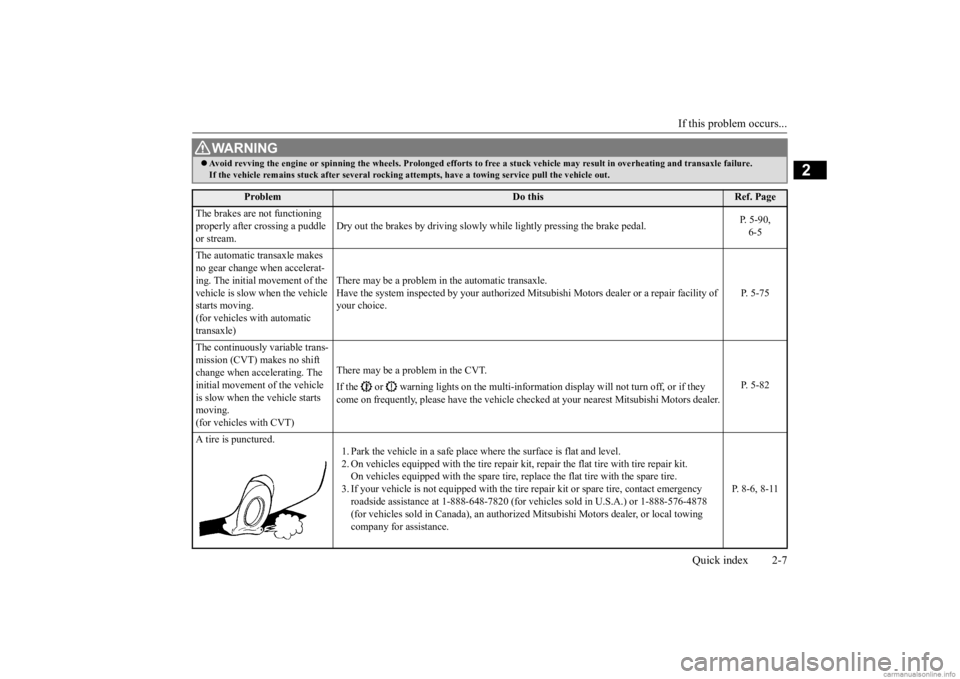
If this problem occurs...
Quick index 2-7
2
Avoid revving the engine or spin
ning the wheels. Prolonged efforts to free a st
uck vehicle may result in
overheating and transa
xle failure.
If the vehicle remains stuck after several rocking attempts, have a towing service pull the vehicle out.
Problem
Do this
Ref. Page
The brakes are not functioning properly after crossing a puddle or stream.
Dry out the brakes by driving slowly
while lightly pressing the brake pedal.
P. 5-90, 6-5
The automatic transaxle makes no gear change when accelerat- ing. The initial movement of the vehicle is slow
when the vehicle
starts moving. (for vehicles with automatic transaxle)
There may be a problem in the automatic transaxle. Have the system inspected by your authorized Mitsub
ishi Motors dealer or
a repair facility of
your choice.
P. 5-75
The continuously variable trans- mission (CVT) makes no shift change when accelerating. The initial movement of the vehicle is slow when the vehicle starts moving.(for vehicles with CVT)
There may be a problem in the CVT. If the or warning lights on the multi-informat
ion display will not turn off, or if they
come on frequently, please have the vehicle chec
ked at your nearest Mits
ubishi Motors dealer.
P. 5-82
A tire is punctured.
1. Park the vehicle in a safe place where the surface is flat and level. 2. On vehicles equipped with the
tire repair kit, repair the flat tire with tire repair kit.
On vehicles equipped with the spare tire, replace the flat tire with the spare tire. 3. If your vehicle is not equippe
d with the tire repair kit or
spare tire, contact emergency
roadside assistance at 1-888-648-7820 (for ve
hicles sold in U.S.A.) or 1-888-576-4878
(for vehicles sold in Canada),
an authorized Mitsubishi Mo
tors dealer, or local towing
company for assistance.
P. 8 - 6 , 8 - 1 1
WA R N I N G
BK0278200US.book 7 ページ 2019年4月10日 水曜日 午前10時59分
Page 46 of 443
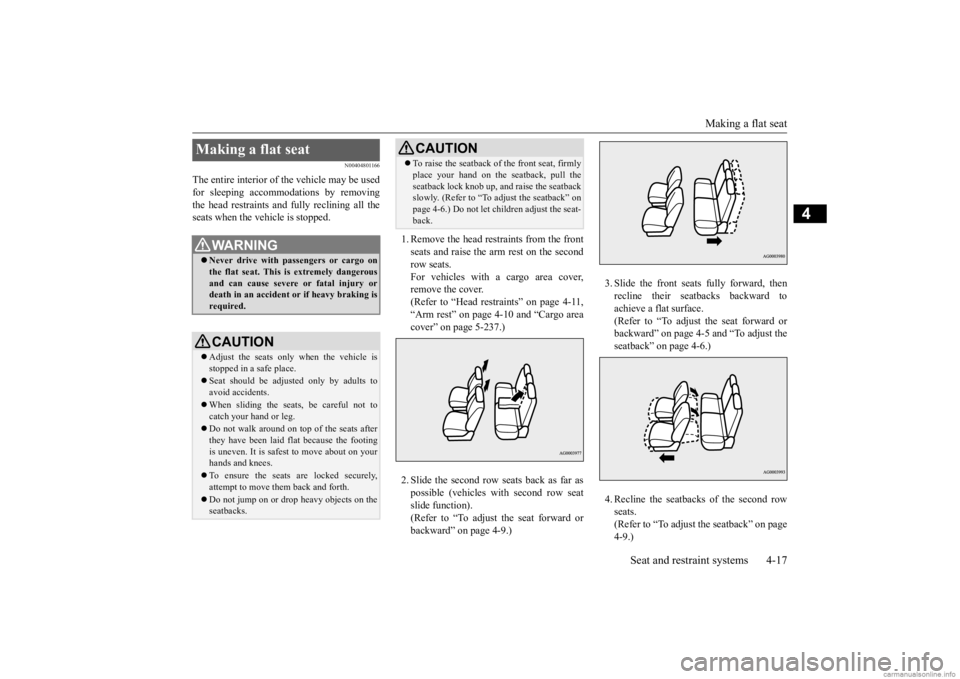
Making a flat seat
Seat and restraint systems 4-17
4
N00404801166
The entire interior of the vehicle may be used for sleeping accomm
odations by removing
the head restraints and fully reclining all theseats when the ve
hicle is stopped.
1. Remove the head re
straints from the front
seats and raise the arm rest on the secondrow seats. For vehicles with a cargo area cover, remove the cover.(Refer to “Head restraints” on page 4-11, “Arm rest” on page 4-10 and “Cargo area cover” on page 5-237.) 2. Slide the second row seats back as far as possible (vehicles with second row seat slide function).(Refer to “To adjust the seat forward or backward” on page 4-9.)
3. Slide the front seats fully forward, then recline their seatbacks backward toachieve a flat surface. (Refer to “To adjust the seat forward or backward” on page 4-5 and “To adjust theseatback” on page 4-6.) 4. Recline the seatbacks of the second row seats.(Refer to “To adjust the seatback” on page 4-9.)
Making a flat seat
WA R N I N G Never drive with passengers or cargo on the flat seat. This is extremely dangerousand can cause severe or fatal injury or death in an accident
or if heavy braking is
required.CAUTION Adjust the seats only when the vehicle is stopped in a safe place. Seat should be adjusted only by adults to avoid accidents. When sliding the seat
s, be careful not to
catch your hand or leg. Do not walk around on top of the seats after they have been laid flat because the footingis uneven. It is safe
st to move about on your
hands and knees. To ensure the seats are locked securely, attempt to move them back and forth. Do not jump on or drop heavy objects on the seatbacks.
To raise the seatback of the front seat, firmly place your hand on th
e seatback, pull the
seatback lock knob up, and raise the seatbackslowly. (Refer to “To adjust the seatback” on page 4-6.) Do not let ch
ildren adjust the seat-
back.CAUTION
BK0278200US.book 17 ページ 2019年4月10日 水曜日 午前10時59分
Page 75 of 443
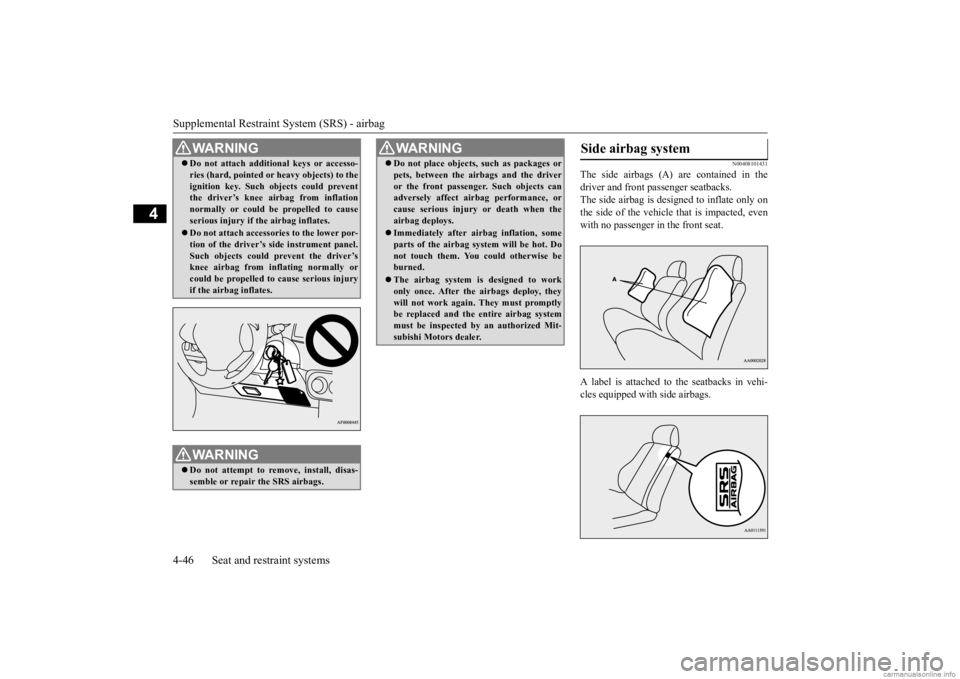
Supplemental Restraint System (SRS) - airbag 4-46 Seat and restraint systems
4
N00408101431
The side airbags (A) are contained in the driver and front passenger seatbacks. The side airbag is de
signed to inflate only on
the side of the vehicle that is impacted, even with no passenger in the front seat. A label is attached to the seatbacks in vehi- cles equipped with side airbags.
Do not attach addition
al keys or accesso-
ries (hard, pointed or
heavy objects) to the
ignition key. Such objects could preventthe driver’s knee ai
rbag from inflation
normally or could be propelled to cause serious injury if
the airbag inflates.
Do not attach accessories to the lower por- tion of the driver’s side instrument panel.Such objects could prevent the driver’s knee airbag from inflating normally or could be propelled to cause serious injuryif the airbag inflates.WA R N I N G Do not attempt to remove, install, disas- semble or repair the SRS airbags.WA R N I N G
Do not place objects,
such as packages or
pets, between the airbags and the driveror the front passenger. Such objects canadversely affect ai
rbag performance, or
cause serious injury or death when the airbag deploys. Immediately after airbag inflation, some parts of the airbag syst
em will be hot. Do
not touch them. You could otherwise be burned. The airbag system is designed to work only once. After the
airbags deploy, they
will not work again. They must promptlybe replaced and the
entire airbag system
must be inspected by
an authorized Mit-
subishi Motors dealer.WA R N I N G
Side airbag system
BK0278200US.book 46 ページ 2019年4月10日 水曜日 午前10時59分
Page 172 of 443
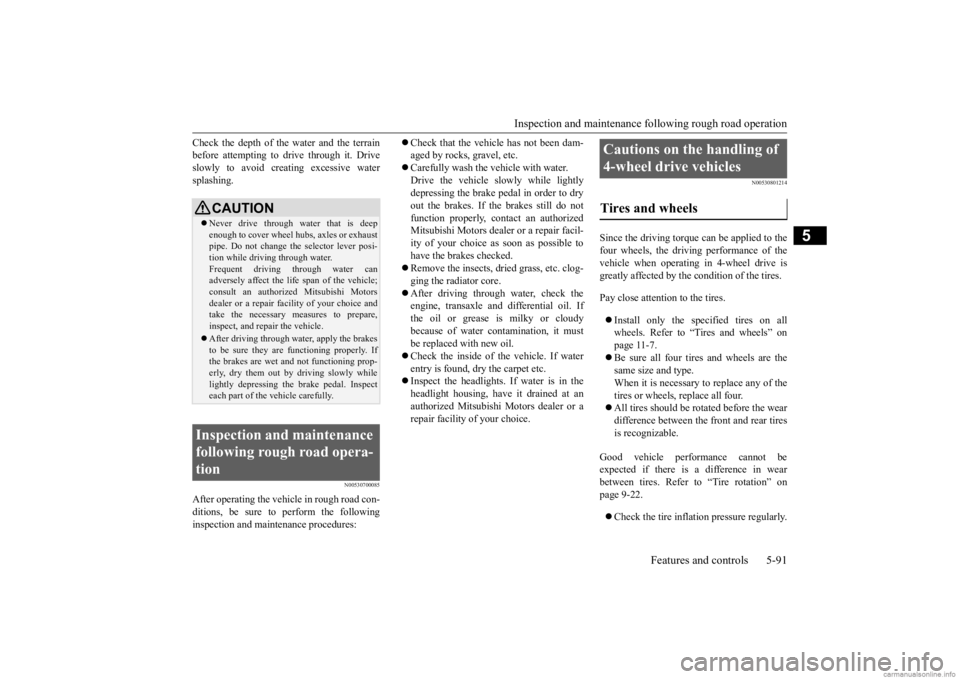
Inspection and maintenance following rough road operation
Features and controls 5-91
5
Check the depth of the water and the terrain before attempting to drive through it. Driveslowly to avoid creating excessive water splashing.
N00530700085
After operating the vehicle in rough road con- ditions, be sure to perform the followinginspection and maintenance procedures:
Check that the vehicle has not been dam- aged by rocks, gravel, etc. Carefully wash the vehicle with water. Drive the vehicle slowly while lightly depressing the brake pedal in order to dryout the brakes. If the brakes still do not function properly, contact an authorized Mitsubishi Motors dealer or a repair facil-ity of your choice as
soon as possible to
have the brakes checked. Remove the inse
cts, dried grass, etc. clog-
ging the radiator core. After driving through water, check the engine, transaxle and
differential oil. If
the oil or grease is milky or cloudy because of water c
ontamination, it must
be replaced with new oil. Check the inside of the vehicle. If water entry is found, dry the carpet etc. Inspect the headlights. If water is in the headlight housing, have
it drained at an
authorized Mitsubishi
Motors dealer or a
repair facility of your choice.
N00530801214
Since the driving torque can be applied to the four wheels, the driving performance of the vehicle when operating in 4-wheel drive is greatly affected by the
condition of the tires.
Pay close attention to the tires. Install only the specified tires on all wheels. Refer to “Tires and wheels” onpage 11-7. Be sure all four tire
s and wheels are the
same size
and type.
When it is necessary to replace any of the tires or wheels, replace all four. All tires should be rotated before the wear difference between the
front and rear tires
is recognizable.
Good vehicle performance cannot be expected if there is a difference in wearbetween tires. Refer to “Tire rotation” on page 9-22. Check the tire inflati
on pressure regularly.
CAUTIONNever drive through water that is deep enough to cover wheel hubs, axles or exhaust pipe. Do not change th
e selector lever posi-
tion while driving through water. Frequent driving through water can adversely affect the life
span of the vehicle;
consult an authorized Mitsubishi Motors dealer or a repair faci
lity of your choice and
take the necessary measures to prepare,inspect, and repair the vehicle. After driving through wa
ter, apply the brakes
to be sure they are functioning properly. If the brakes are wet and not functioning prop- erly, dry them out by
driving slowly while
lightly depressing the
brake pedal. Inspect
each part of the vehicle carefully.
Inspection and maintenance following rough road opera-tion
Cautions on the handling of 4-wheel drive vehicles Tires and wheels
BK0278200US.book 91 ページ 2019年4月10日 水曜日 午前10時59分
Page 194 of 443
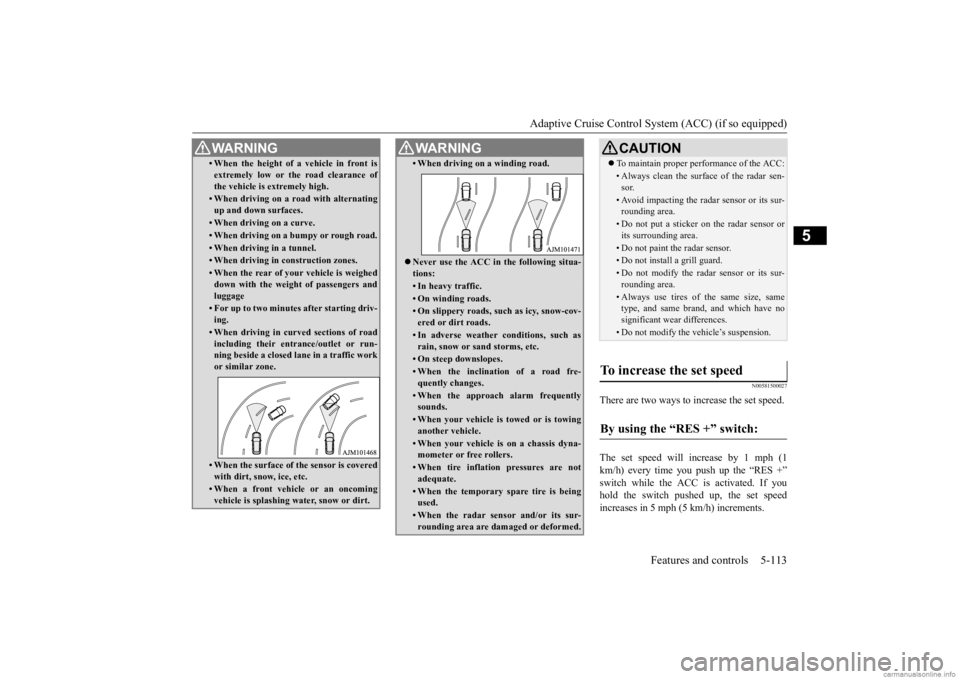
Adaptive Cruise Control System (ACC) (if so equipped)
Features and controls 5-113
5
N00581500027
There are two ways to increase the set speed. The set speed will increase by 1 mph (1 km/h) every time you push up the “RES +” switch while the ACC is activated. If youhold the switch pushed up, the set speed increases in 5 mph (5 km/h) increments.
• When the height of a vehicle in front is extremely low or the road clearance ofthe vehicle is extremely high.• When driving on a r
oad with alternating
up and down surfaces.• When driving on a curve.• When driving on a bumpy or rough road.• When driving in a tunnel.• When driving in construction zones.• When the rear of your vehicle is weighed down with the weight of passengers and luggage• For up to two minute
s after starting driv-
ing.• When driving in curved sections of roadincluding their entrance/outlet or run-ning beside a closed lane in a traffic work or similar zone.• When the surface of the sensor is covered with dirt, snow, ice, etc.• When a front vehicl
e or an oncoming
vehicle is splashing wa
ter, snow or dirt.
WA R N I N G
• When driving on
a winding road.
Never use the ACC in the following situa- tions:• In heavy traffic.• On winding roads.• On slippery roads, su
ch as icy, snow-cov-
ered or dirt roads.• In adverse weather
conditions, such as
rain, snow or sand storms, etc.• On steep downslopes.• When the inclination of a road fre-quently changes.• When the approach alarm frequentlysounds.• When your vehicle is towed or is towinganother vehicle.• When your vehicle is on a chassis dyna-mometer or free rollers.• When tire inflation pressures are notadequate.• When the temporary spare tire is beingused.• When the radar sensor and/or its sur-rounding area are damaged or deformed.WA R N I N G
CAUTION To maintain proper performance of the ACC:• Always clean the surface of the radar sen- sor.• Avoid impacting the radar sensor or its sur-rounding area.• Do not put a sticker on the radar sensor orits surrounding area.• Do not paint the radar sensor.• Do not install a grill guard.• Do not modify the radar sensor or its sur- rounding area.• Always use tires of the same size, sametype, and same brand,
and which have no
significant wear differences.• Do not modify the vehicle’s suspension.
To increase the set speed
By using the “RES +” switch:
BK0278200US.book 113 ページ 2019年4月10日 水曜日 午前10時59分
Page 203 of 443
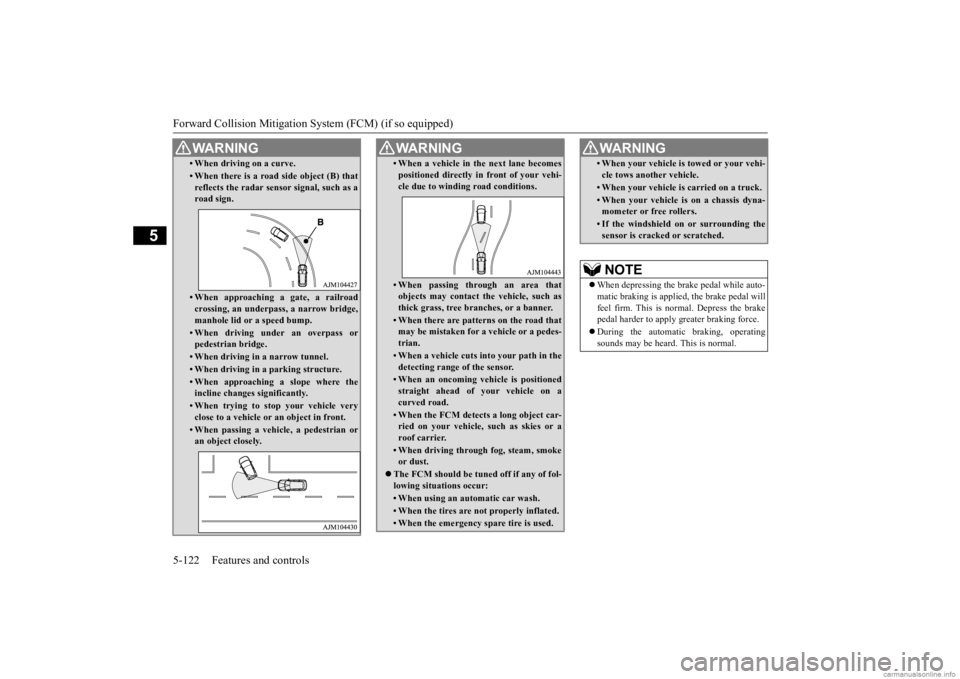
Forward Collision Mitigation System (FCM) (if so equipped) 5-122 Features and controls
5
• When driving on a curve.• When there is a road side object (B) that reflects the radar sensor signal, such as a road sign.• When approaching
a gate, a railroad
crossing, an underpas
s, a narrow bridge,
manhole lid or
a speed bump.
• When driving under an overpass or pedestrian bridge.• When driving in a narrow tunnel.• When driving in a parking structure.• When approaching a slope where the incline changes
significantly.
• When trying to st
op your vehicle very
close to a vehicle or
an object in front.
• When passing a vehicle, a pedestrian or an object closely.WA R N I N G
• When a vehicle in the next lane becomespositioned directly in
front of your vehi-
cle due to winding road conditions.• When passing through an area that objects may contact the vehicle, such as thick grass, tree branches, or a banner.• When there are patterns on the road thatmay be mistaken for a vehicle or a pedes-trian.• When a vehicle cuts into your path in thedetecting range of the sensor.• When an oncoming ve
hicle is positioned
straight ahead of your vehicle on a curved road.• When the FCM detects a long object car-ried on your vehicle,
such as skies or a
roof carrier.• When driving through fog, steam, smokeor dust.
The FCM should be tune
d off if any of fol-
lowing situations occur:• When using an automatic car wash.• When the tires are not properly inflated. • When the emergency spare tire is used.WA R N I N G
• When your vehicle is
towed or your vehi-
cle tows another vehicle.• When your vehicle is carried on a truck.• When your vehicle is on a chassis dyna-mometer or free rollers.•If the windshield on
or surrounding the
sensor is cracke
d or scratched.
NOTE
When depressing the brake pedal while auto- matic braking is applied, the brake pedal will feel firm. This is normal. Depress the brake pedal harder to apply
greater braking force.
During the automatic
braking, operating
sounds may be heard. This is normal. WA R N I N G
BK0278200US.book 122 ページ 2019年4月10日 水曜日 午前10時59分
Page 221 of 443
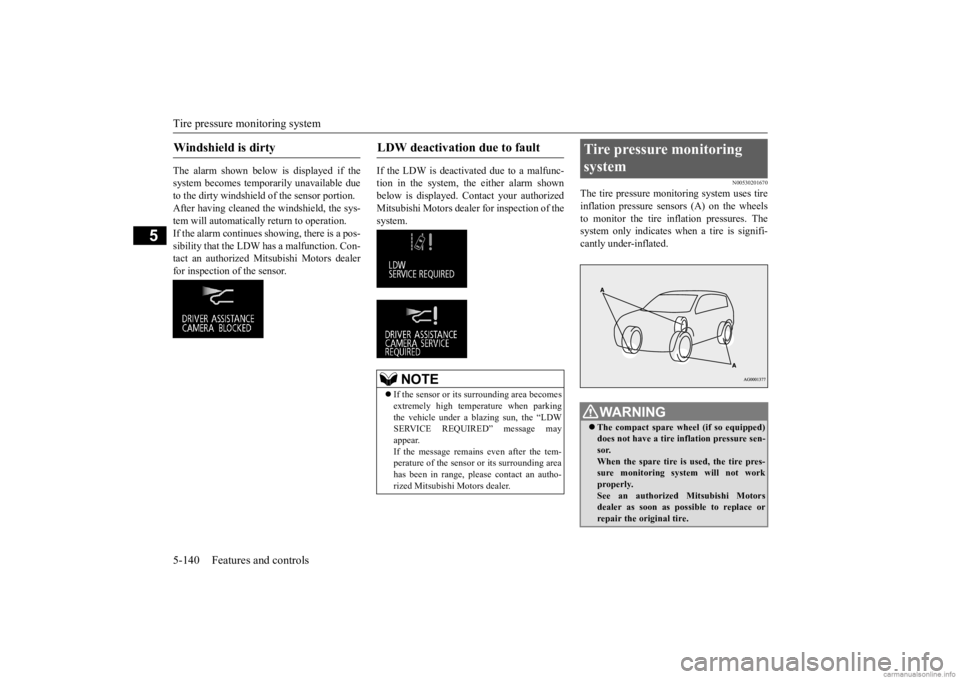
Tire pressure monitoring system 5-140 Features and controls
5
The alarm shown below is displayed if the system becomes temporarily unavailable due to the dirty windshield of the sensor portion. After having cleaned the windshield, the sys-tem will automatically return to operation. If the alarm continues s
howing, there is a pos-
sibility that the LDW
has a malfunction. Con-
tact an authorized Mitsubishi Motors dealer for inspection of the sensor.
If the LDW is deactiva
ted due to a malfunc-
tion in the system, the either alarm shown below is displayed.
Contact your authorized
Mitsubishi Motors dealer for inspection of thesystem.
N00530201670
The tire pressure moni
toring system uses tire
inflation pressure sensors (A) on the wheels to monitor the tire inflation pressures. Thesystem only indicates wh
en a tire is signifi-
cantly under-inflated.
Windshield is dirty
LDW deactivation due to fault
NOTE
If the sensor or its surrounding area becomes extremely high temperature when parking the vehicle under a bl
azing sun, the “LDW
SERVICE REQUIRED” message may appear. If the message remains even after the tem-perature of the sensor or its surrounding area has been in range, plea
se contact an autho-
rized Mitsubishi Motors dealer.
Tire pressure monitoring system
WA R N I N G The compact spare wheel (if so equipped) does not have a tire inflation pressure sen-sor. When the spare tire is used, the tire pres- sure monitoring system will not workproperly. See an authorized
Mitsubishi Motors
dealer as soon as po
ssible to replace or
repair the original tire.
BK0278200US.book 140 ページ 2019年4月10日 水曜日 午前10時59分
Page 222 of 443
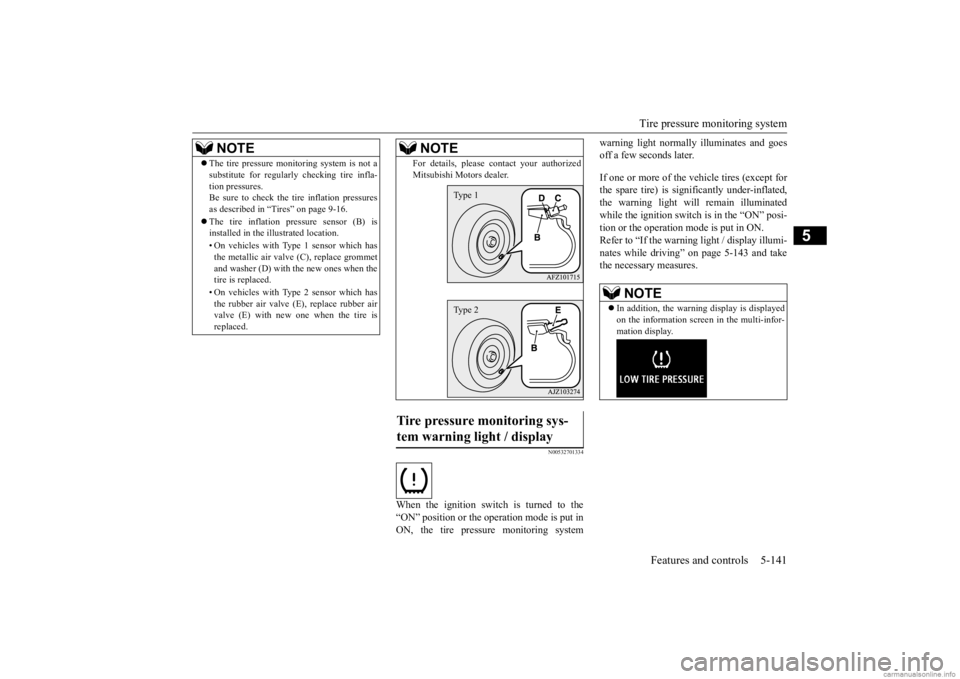
Tire pressure monitoring system
Features and controls 5-141
5
N00532701334
When the ignition switch is turned to the “ON” position or the ope
ration mode is put in
ON, the tire pressure monitoring system
warning light normally
illuminates and goes
off a few seconds later. If one or more of the vehicle tires (except for the spare tire) is significantly under-inflated, the warning light will remain illuminated while the ignition switch is in the “ON” posi-tion or the operation mode is put in ON. Refer to “If the warning light / display illumi- nates while driving” on
page 5-143 and take
the necessary measures.
NOTE
The tire pressure monitoring system is not a substitute for regularly
checking tire infla-
tion pressures.Be sure to check the tire inflation pressures as described in “Tires” on page 9-16. The tire inflation pressure sensor (B) is installed in the illustrated location. • On vehicles with Type
1 sensor which has
the metallic air valve (C), replace grommet and washer (D) with the new ones when thetire is replaced. • On vehicles with Type
2 sensor which has
the rubber air valve (E), replace rubber air valve (E) with new one when the tire is replaced.
For details, please
contact your authorized
Mitsubishi Moto
rs dealer.
Tire pressure monitoring sys- tem warning light / display
NOTE
Type 1Type 2
NOTE
In addition, the warni
ng display is displayed
on the information screen in the multi-infor-mation display.
BK0278200US.book 141 ページ 2019年4月10日 水曜日 午前10時59分